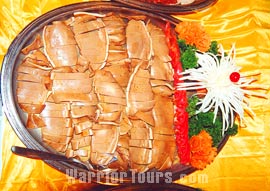Eight Cuisines
China covers a large territory and has many nationalities, hence a variety of Chinese food with different but fantastic and mouthwatering flavor. Since China's local dishes have their own typical characteristics, generally, Chinese food can be roughly divided into eight regional cuisines, which has been widely accepted around. Certainly, there are many other local cuisines which are famous, such as Beijing Cuisine and Shanghai Cuisine.
![]() Shandong Cuisine
Shandong Cuisine
Consisting of Jinan cuisine and Jiaodong cuisine, Shandong cuisine, clear, pure and not greasy, is characterized by its emphasis on aroma, freshness, crispness and tenderness. Shallot and garlic are usually used as seasonings so Shangdong dishes tastes pungent usually. Soups are given much emphasis in Shangdong dishes. Thin soup features clear and fresh while creamy soup looks thick and tastes strong. Jinan cuisine is adept at deep-frying, grilling, frying and stir-frying while Jiaodong division is famous for cooking seafood with fresh and light taste.
![]() Typical Courses: Bird's Nest Soup; the Yellow River Carp in Sweet and Sour sauce
Typical Courses: Bird's Nest Soup; the Yellow River Carp in Sweet and Sour sauce

![]() Sichuan Cuisine
Sichuan Cuisine
Sichuan Cuisine, known often in the West as Szechuan Cuisine, is one of the most famous Chinese cuisines in the world. Characterized by its spicy and pungent flavor, Sichuan cuisine, prolific of tastes, emphasizes on the use of chili. Pepper and prickly ash also never fail to accompany, producing typical exciting tastes. Besides, garlic, ginger and fermented soybean are also used in the cooking process. Wild vegetables and animals are usually chosen as ingredients, while frying, frying without oil, pickling and braising are applied as basic cooking techniques.
It cannot be said that one who does not experience Sichuan food ever reaches China.
![]() Typical Courses: Hot Pot; Smoked Duck; Kung Pao Chicken; Twice Cooked Pork; Mapo Dofu
Typical Courses: Hot Pot; Smoked Duck; Kung Pao Chicken; Twice Cooked Pork; Mapo Dofu
![]() Guangdong Cuisine (Cantonese Cuisine)
Guangdong Cuisine (Cantonese Cuisine)
Tasting clear, light, crisp and fresh, Guangdong cuisine, familiar to Westerners, usually chooses raptors and beasts to produce originative dishes. Its basic cooking techniques include roasting, stir-frying, sauteing, deep-frying, braising, stewing and steaming. Among them Steaming and stir-frying are more commonly applied to preserve the natural flavor. Guangdong chefs also pay much attention to the artistic presentation of dishes.
![]() Typical Courses: Shark's Fin Soup; Steamed Sea Bass; Roasted Piglet
Typical Courses: Shark's Fin Soup; Steamed Sea Bass; Roasted Piglet

![]() Fujian Cuisine
Fujian Cuisine
Consisting of Fuzhou Cuisine, Quanzhou Cuisine and Xiamen Cuisine, Fujian Cuisine is distinguished for its choice seafood, beautiful color and magic taste of sweet, sour, salty and savory. The most distinct features are their 'pickled taste'.
![]() Typical Courses: Buddha Jumping Over the Wall; Snow Chicken; Prawn with Dragon's Body and Phoenix's tail
Typical Courses: Buddha Jumping Over the Wall; Snow Chicken; Prawn with Dragon's Body and Phoenix's tail
![]() Jiangsu Cuisine
Jiangsu Cuisine
Jiangsu Cuisine, also called Huaiyang Cuisine, is popular in the lower reach of the Yangtze River. Aquatics as the main ingredients, it stresses the freshness of materials. Its carving techniques are delicate, of which the melon carving technique is especially well known. Cooking techniques consist of stewing, braising, roasting, simmering, etc. The flavor of Huaiyang Cuisine is light, fresh and sweet and with delicate elegance.
![]() Typical Courses: Stewed Crab with Clear Soup, Long-boiled and Dry-shredded Meat, Duck Triplet, Crystal Meat, Squirrel with Mandarin Fish, and Liangxi Crisp Eel
Typical Courses: Stewed Crab with Clear Soup, Long-boiled and Dry-shredded Meat, Duck Triplet, Crystal Meat, Squirrel with Mandarin Fish, and Liangxi Crisp Eel
![]() Zhejiang Cuisine
Zhejiang Cuisine
Comprising local cuisines of Hanzhou, Ningbo and Shaoxing, Zhejiang Cuisine, not greasy, wins its reputation for freshness, tenderness, softness, smoothness of its dishes with mellow fragrance. Hangzhou Cuisine is the most famous one among the three.
![]() Typical Courses: Sour West Lake Fish, Longjing Shelled Shrimp, Beggar's Chicken
Typical Courses: Sour West Lake Fish, Longjing Shelled Shrimp, Beggar's Chicken
![]() Hunan Cuisine
Hunan Cuisine
Hunan cuisine consists of local Cuisines of Xiangjiang Region, Dongting Lake and Xiangxi coteau. It characterizes itself by thick and pungent flavor. Chili, pepper and shallot are usually necessaries in this division.
![]() Typical Courses: Dongan Chick; Peppery and Hot Chick
Typical Courses: Dongan Chick; Peppery and Hot Chick
![]() Anhui Cuisine
Anhui Cuisine
Anhui Cuisine chefs focus much more attention on the temperature in cooking and are good at braising and stewing. Often hams will be added to improve taste and sugar candy added to gain freshness.
![]() Typical Courses: Stewed Snapper; Huangshan Braised Pigeon
Typical Courses: Stewed Snapper; Huangshan Braised Pigeon

